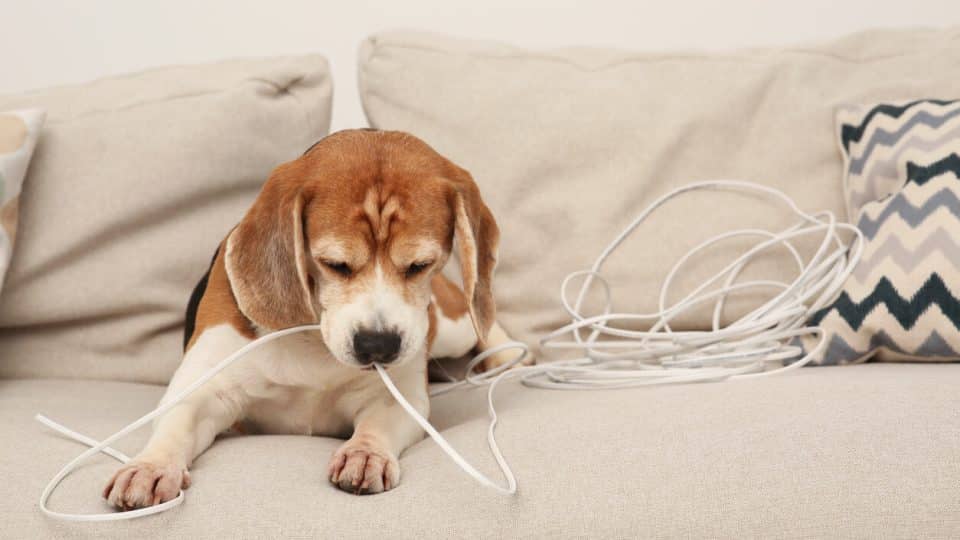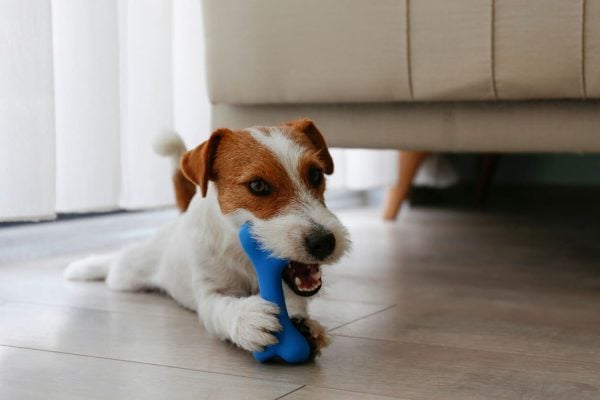- This post contains affiliate links. Read more here.
- Not a substitute for professional veterinary help.
If your dog has suddenly started chewing electrical cords, it’s important to understand why. Finding the cause can help you prevent them from chewing cords, which is essential for their safety.
“Dogs chew because of their natural behaviors and needs,” explains Brie Blakeman, certified canine behavior consultant, certified professional dog trainer, and founder of Noble Woof Dog Training.
“For many dogs, the firm yet slightly flexible texture of electrical cords is satisfying to chew on. Puppies may chew electrical cords to relieve sore gums while teething. Other dogs may also chew because of stress or a lack of exercise.”
Read on to learn how to stop your dog from chewing electrical cords and what you can do to keep your dog safe from electrocution.
Pro-tip: Got a cord chomper on your hands? Professional dog training can help you prevent unwanted behavior. Search for a dog trainer near you who specializes in chewing behaviors.
Best Ways to Prevent Your Dog from Chewing Electrical Cords
Blakeman shares six tips to help keep your dog from chewing cords.
Hide or cover power cords
Similar to how you put away shoes to keep your dog from chewing them, the same applies to electrical cords.
“Hiding or covering power cords removes the temptation without having to constantly redirect your dog,” Blakeman says. “Use cord concealers, PVC piping, or specialized cord covers to make them inaccessible to your dog while maintaining the cords’ functionality.”
Block access to power cords
If you have cords you can’t hide from your dog, you can try blocking their access instead.
Blakeman suggests using a dog gate or closed doors to restrict access to areas with cords when you can’t actively supervise your dog.
Give your dog an alternative chew
Chewing is a natural, instinctive behavior for dogs, so providing them with appropriate outlets for chewing is essential.
“Offer a variety of textures, including rubber toys, natural chews, or puzzle toys with treats, that provide sensations your dog seeks,” Blakeman says. “Rotate their toys regularly to discover your dog’s preferences and maintain their interest.”
Monitor your dog and interrupt before they chew
Blakeman explains that “errorless learning” means setting your dog up for success through careful supervision and management. She says to gently redirect your dog to appropriate toys as soon as it seems they may be interested in chewing electrical cords.
Redirecting their behavior as soon as possible creates a positive learning experience without the need for punishment. Then you can find ways to block their access to the cords and keep them from chewing in the future.
Train your dog to leave it
Teaching your dog the “leave it” command is a great way to help keep them safe in many scenarios, including when they’re interested in chewing electrical cords.
Blakeman suggests training your dog in a distraction-free environment. Start with low-value items your dog doesn’t find particularly motivating, like their regular food or a common toy.
After your dog shows consistent success, you can gradually increase the difficulty of training with a high-temptation item like a cord.
If possible, train your dog two or three times a day for 5 to 10 minutes at a time. Whenever your dog successfully “leaves it,” offer praise and a reward for positive reinforcement.
Spray bitter substance to deter chewing
Using bitter spray on the cords your dog likes to chew can create a negative taste association without fear or pain.
However, Blakeman says most dogs eventually develop a tolerance for the taste and resume chewing. That’s why it’s most effective to prevent access and train your dog to chew the right things instead.
You can use a bitter substance temporarily while you make a plan to cover or hide cords and start training your dog.
Signs of Electrocution in Dogs
It’s important to keep your dog from chewing electrical cords so they don’t get shocked or electrocuted. Electrocution can cause burns or cardiac arrest.
Signs of electrocution include:
Symptoms may show up slowly, sometimes a few days after electrocution happens.
If your dog gets electrocuted, you should immediately:
- Unplug the electrical cord or shut off the electricity.
- Check your dog’s heart and respiratory rate and begin CPR if necessary.
- If your dog is breathing, check their mouth for burns, if possible, and apply cool compresses.
- Cover your dog with a blanket to prevent heat loss.
- Contact your vet for next steps, even if your dog seems fine.
Keeping Your Dog Safe
Dogs often chew because of teething discomfort, a lack of mental stimulation, or to satisfy their natural need to chew.
Making sure you meet your dog’s needs can help you keep them safe, happy, and healthy. If you notice your dog chewing electrical cords, consider the possible needs your dog is trying to meet. Blakeman says this perspective shift can help you find and address the root causes for better success.
To prevent destructive chewing and other unwanted behaviors, consider incorporating the following:
- Regular physical exercise appropriate for their age, breed, and health status
- Mental enrichment through trick and obedience training at home, puzzle toys, and nosework
- Various chew toys that match their preferences
- A consistent routine that provides security and predictability
- Working with a professional dog trainer for extra help and support — to get started, learn how dog training works on Rover!






